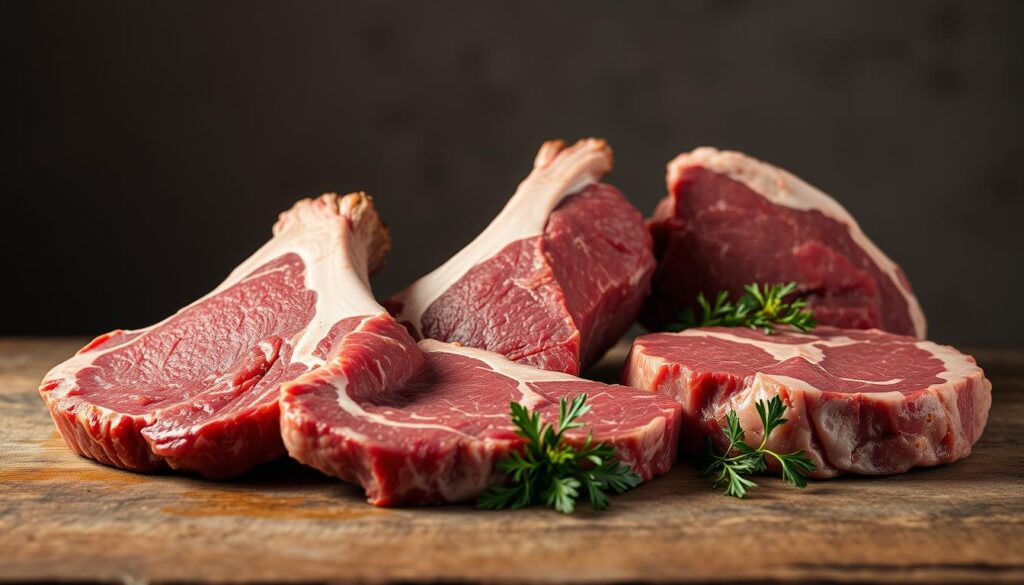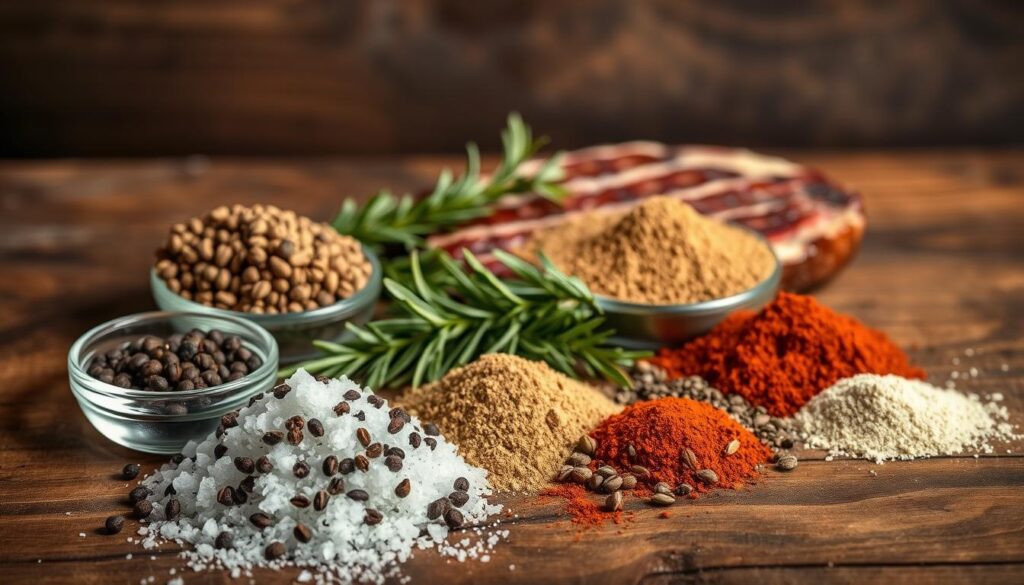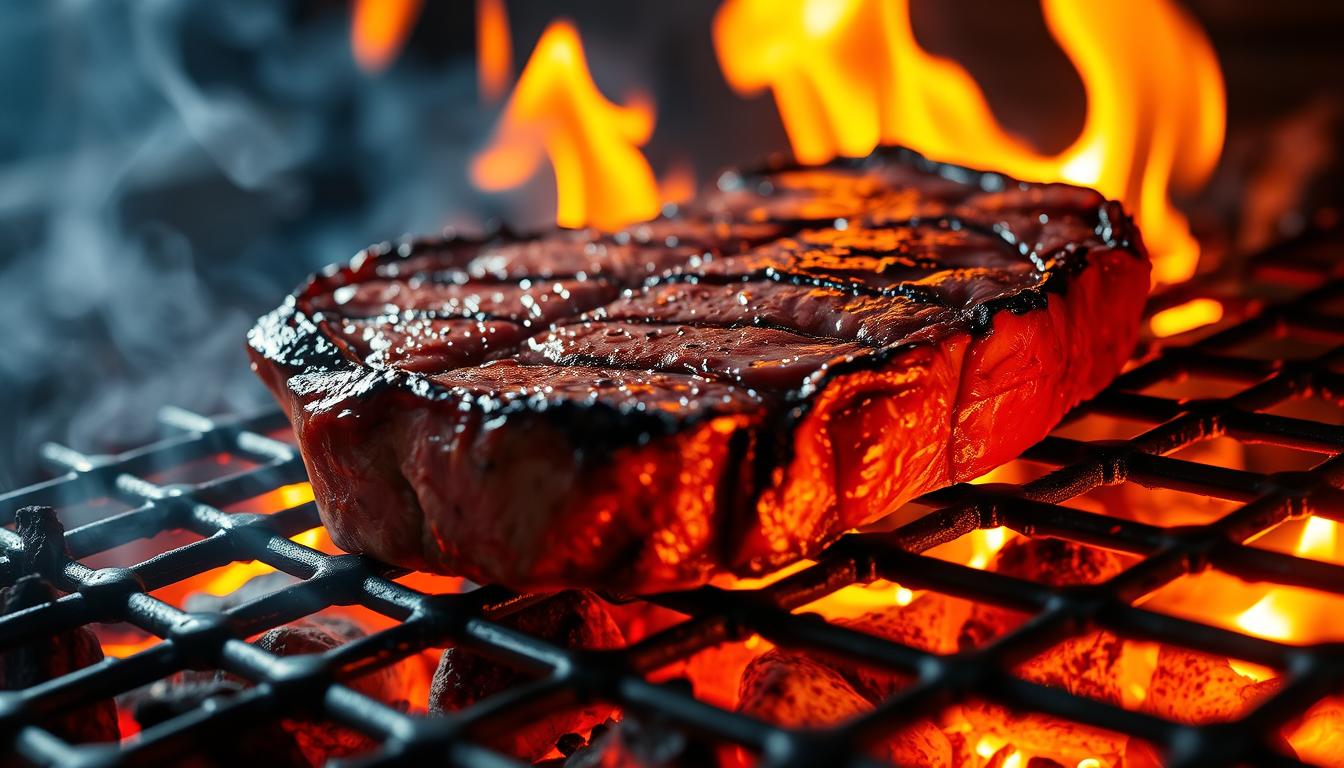Table of Contents
Juicy Grilled Ribeye Steak brings the sizzle of a perfectly grilled ribeye to life. It’s juicy steak that melts in your mouth, with a crust that crackles with flavor. For years, I’ve been perfecting this dish, blending tips from Kevin Is Cooking’s Montreal seasoning techniques and SpendWithPennies’ advice on dry rubs.
Every time I fire up the grill, I’m reminded why ribeye is my favorite. That marbling of fat, the bold taste, and the joy of watching the juices pool on the plate. It’s more than a meal—it’s a celebration of simple, bold flavors.
Key Takeaways
- Use Montreal seasoning and a dry rub to lock in juices.
- Rest the steak 20+ minutes after seasoning to enhance flavor.
- Preheat the grill to 450-500°F for a golden crust.
- Finish with compound butter for a rich, creamy finish.
- Always rest the steak 5-10 minutes post-cook to keep it juicy.
Selecting the Perfect Cut
Choosing the right meat selection begins at the butcher. The best ribeye steaks are from USDA Prime or Choice grades. Chef Michael Lomonaco suggests a 1.5-inch bone-in ribeye for even cooking and flavor.

Understanding Ribeye Grades
USDA grades show the meat’s quality. Here’s a quick guide:
| Grade | Marbling | Tenderness | Cost |
|---|---|---|---|
| Prime | Abundant | Extremely tender | High |
| Choice | Good | Tender | Moderate |
| Select | Minimal | Less tender | Lowest |
Tips for Freshness and Quality
- Look for marbling – white streaks of fat within the red meat.
- Choose steaks 1”+ thick for even cooking. Thin cuts dry out faster.
- Bone-in options (like “cowboy ribeye”) add flavor and hold heat better.
- Check the color: deep red with a slight sheen means freshness.
Always pat the steak dry before seasoning. Proper meat selection leads to better grilling results. SpendWithPennies.com agrees that marbling is key for juiciness.
Seasoning: A Personal Touch
Great steak seasoning turns a ribeye into a work of art. My favorite dry rub has been perfected over years of grilling. It’s not just about taste—it helps the steak keep its juices and gets a crispy crust.

| Ingredient | Amount |
|---|---|
| Kosher salt | 1 tbsp |
| Cracked black pepper | 2 tsp |
| Garlic powder | 1 tbsp |
| Onion powder | 2 tsp |
| Smoked paprika | 1 tbsp |
| Dried rosemary | 1.5 tsp |
| Dried thyme | 1.5 tsp |
Spread this mix on both sides of the steak. Then, let it sit at room temperature for 20 minutes. This lets the flavors mix and brings moisture to the surface for better searing. Use Himalayan or kosher salt for even seasoning without too much salt.
- Alternative options: Montreal Steak Seasoning or Lawry’s Garlic Salt work well
- For smoky depth, add ½ tsp chipotle powder
- Avoid liquid marinades here—this is a dry rub technique
Timing is crucial: Season 20 minutes before grilling. This lets the steak absorb flavors without drying out. This method is also recommended by experts like Kevin Is Cooking for the best crust.
Grilling Tools and Setup
Mastering the ribeye starts with the right grill tools and a thoughtful setup. My go-to essentials include a ThermoWorks Thermapen ONE for precise temperature checks. I also use a sturdy grill brush for cleaning grates. Quality cast iron grates or GrillGrates help with even heat distribution. Here are the must-haves:
Recommended Grill Equipment
- Charcoal starter: Use a chimney starter for consistent ignition
- Heat control: Royal Oak Charcoal Hardwood Pellets for steady burning
- Safety gear: Nechtik BBQ Gloves to handle hot surfaces
- Prep tools: Heavy-duty aluminum foil for cleanup and wire cooling racks
- Temperature management: Digital meat thermometers for 115°F accuracy
Safety and Maintenance Tips
| Task | How To |
|---|---|
| Grill Prep | Preheat gas grills on high for 30 minutes. For charcoal, arrange coals in a two-zone fire setup |
| Grate Care | Brush grates clean then spray with olive oil before cooking |
| Tool Storage | Store grill tools in a dry area to prevent rust |
Invest in a PK 360 Grill for consistent performance. Always check gas tank connections and store charcoal in a dry container. Proper maintenance extends grill lifespan and ensures perfect sears every time. With the right grill tools and smart setup, you’re ready to tackle the next step—mastering the heat!
Finding the Ideal Grill Temperature
Getting the grill temperature right is key to a perfect ribeye. Start by heating your grill to 450–500°F. This high heat creates a crispy crust. I use a thermometer to keep an eye on the grill temperature and avoid overcooking.
For charcoal grills, aim for white-hot coals. Gas grills should be at 500°F for even heat. This ensures your steak cooks perfectly.
- Preheat to 450–500°F and let the grill stabilize.
- Use indirect heat (325–350°F) after searing for even cooking.
- Remove steak when it’s 5°F below target internal temp—resting will finish the job.
| Doneness | Target Internal Temp (°F) | Cooking Time (Minutes) | Resting Temp (°F) |
|---|---|---|---|
| Medium-Rare | 125–130°F | 12–16 | 130–135°F |
| Medium | 135–140°F | 13–15 | 140–145°F |
| Medium-Well | 145–150°F | 16–18 | 150–155°F |
| Well-Done | 155–160°F | 18–20 | 160–165°F |
Always check the internal temp with a probe. Kevin Is Cooking and Plating Pixels say this method keeps juices in. Adjust your grill’s vents or move the steak to cooler zones to control the grill temperature. Patience and precision here make all the difference!
Grilled Ribeye Steak: My Personal Technique
Every bite of a perfectly grilled ribeye starts with precision. My method balances timing and temperature to ensure tenderness and flavor. Here’s how I achieve that ideal balance:
Step-by-Step Cooking Process
- Bring steak to room temperature for 45 minutes to reduce cooking time inconsistency.
- Season with coarse sea salt and pepper at least 40 minutes before grilling.
- Preheat grill to 400°F-450°F using hardwood coals for smoky flavor.
- Sear 1-inch thick steaks 4-6 minutes per side, rotating 45° halfway.
- Flip every 5 minutes during initial cooking to ensure even doneness.
Temperature and Timing Guidelines
| Doneness | Internal Temp | Cooking Time |
|---|---|---|
| Rare | 120°F | 8-10 mins total |
| Medium-Rare | 130°F | 10-12 mins total |
| Medium | 140°F | 12-15 mins total |
After grilling, rest the steak for 5-10 minutes. Remember, internal temp rises 5°F during rest. Use a meat thermometer—don’t guess! Slice against the grain for maximum tenderness.
Pro tip: Bone-in ribeyes with good marbling hold moisture better. For ultra-thick cuts (over 1.5″), start at low heat before final high-heat sear. Adjust cooking time based on steak thickness.
Achieving a Flavorful Marination Process
A good steak marinade makes ribeye unforgettable. I choose dry rubs over wet marinades for ribeye. This is because its natural marbling already adds rich flavor. Dry rubs like garlic powder, rosemary, and black pepper enhance the flavor without overpowering the meat’s tenderness.
My favorite mix includes olive oil, soy sauce, lemon juice, and minced garlic. Here’s how to use it:
- Pat steak dry first to ensure seasonings stick
- Massage the rub into both sides, focusing on the fat marbling
For ribeye, marinate 4-6 hours in the fridge. Thicker cuts like sirloin need 8 hours, while thin skirt steak only needs 2. Flip the steak halfway through to coat evenly. Pro tip: Scrape off the dry rub before grilling to avoid burning the spices.
Science shows acids in lemon juice break down proteins slightly. But too long can make meat mushy. Always store in a sealed bag, squeezing out air. Discard leftover marinade after use—it’s unsafe to reuse raw meat-soaked liquid without boiling.
My favorite touch? Adding chopped fresh rosemary. It boosts aroma without masking the steak’s natural beefy taste. This method delivers 35g protein per serving, keeping the focus on flavor without overwhelming the ribeye’s own richness.
Mastering the Sear for a Juicy Finish
Getting the sear right makes your ribeye’s outside golden and the inside tender. High heat triggers the Maillard reaction, adding deep flavors without drying the meat.
Perfect Sear Techniques
First, season the steak with kosher salt 4-48 hours before. Here’s how to sear it perfectly:
- Preheat a cast iron skillet to 700°F on the stovetop.
- Sear the steak 1-3 minutes per side until it’s dark brown.
- Lower the heat to low, then baste with garlic butter, thyme, and rosemary for extra moisture.
Managing High Heat for a Crust
Let’s look at two ways to get the perfect sear and doneness:
| Method | Steps | Heat |
|---|---|---|
| Traditional Sear | High-heat initial sear then indirect cooking | 700°F initial → 225°F finish |
| Reverse Sear | Cook low first, then finish with sear | 225°F → 300-350°F final sear |
Use a thermometer to check the steak’s internal temperature. Remove it when it hits 100°F. Let it rest 5-10 minutes to keep the juices in.
Brushing butter during the last minutes adds richness without causing flare-ups. Make sure not to overcrowd the pan to keep the heat even.
Timing Your Grill to Lock in Juices
Mastering timing is key to perfect ribeye steak. Here’s how to balance heat and rest periods for maximum flavor:
Resting and Monitoring the Steak
After searing, let the steak rest for 5-10 minutes wrapped in foil. This stops juices from escaping. Use a meat thermometer to track the internal temp.
Remove the steak when it’s 5°F below your target (e.g., 140°F for medium). This avoids overcooking. SpendWithPennies.com says resting ensures even juiciness.
Optimal Grilling Duration
Grill times depend on the steak’s thickness. For 1-inch steaks, cook 2-3 minutes per side at 500-650°F. Kevin Is Cooking suggests not flipping too soon.
USDA advises a 3-minute rest, but extending to 10 minutes locks in moisture. This prevents the meat from drying out.
- Preheat grill to 500-650°F before placing steaks.
- Check internal temp regularly to adjust cooking time.
- Resting in foil keeps steak warm while juices redistribute.
Patience is crucial here. My own tests show that precise timing and rest periods make all the difference. Follow these steps, and every bite stays tender and juicy.
Plating and Serving with Love
Once your ribeye is perfectly cooked, the final step turns a good meal into a memorable one. is the grand finale—every detail counts. Start by placing your steak slightly off-center. Add sides like roasted veggies or arugula to add color and contrast.
- Pair with crisp salads, creamy mashed potatoes, or a caprese salad for texture balance.
- Drizzle sauces in swirls using steak drippings for rich flavor and visual flair.
- Finish with a sprinkle of fresh herbs like parsley or chives for a pop of green.
| Side Dish | Why It Works |
|---|---|
| Baked potatoes | Soft texture contrasts with steak’s crunch |
| Salsa verde | Bright herb flavors cut through rich steak |
| Asparagus spears | Earthy taste and vibrant green color |
My go-to is serving a wedge of lemon alongside—squeeze it over the steak just before eating. For serving a crowd, keep a butter pat on top of the steak while resting. Let guests decide how much herb butter to add. Always wipe the plate’s edges clean before presenting—it’s the little details that make home-cooked meals feel special.
Take inspiration from restaurants: arrange ingredients in concentric circles or diagonally. A sprinkle of flaky salt on the steak’s surface adds both taste and texture. Remember, the goal is to make your plate look as inviting as it tastes.
Conclusion
Grilling a ribeye steak is all about paying attention to every detail. Start by picking a cut with lots of marbling for flavor. Season it with coarse salt and pepper for that extra kick.
Use a two-zone grill and keep the temperature between 137–140°F for a perfect medium-rare. Letting the steak rest for 5–10 minutes is key. This step helps the juices spread evenly, making the steak tender and juicy.
Places like Rosebud Steakhouse in Chicago show how important these steps are. They use high-quality Midwestern beef and a simple herb butter sauce. This lets the natural flavors of the steak shine through.
Whether you’re grilling at home or eating out, patience is crucial. I found that a 10-minute rest after 10 minutes of grilling keeps the juices in.
Try different seasonings and grilling times, but always remember to rest the steak. Share your experiences and keep improving your grilling skills. Great grilling is about finding the right balance of science and tradition. Now it’s your turn to make that unforgettable bite.
FAQ
What is the best grade of ribeye steak to choose?
USDA Prime ribeye steak is the top choice for its rich flavor and marbling. USDA Choice is also excellent, offering quality and taste. Look for steaks with visible marbling for juiciness and tenderness.
How long should I let my ribeye steak marinate?
For a dry marinade, let the steak sit at room temperature for about 20 minutes before grilling. This step helps the flavors penetrate and creates a great crust.
What temperature should my grill be for cooking ribeye steak?
Heat your grill to 450°F-500°F for the best results. High heat sears the steak and locks in juices. Lowering the temperature helps achieve the perfect doneness.
What tools do I need for grilling ribeye steak?
You’ll need a quality grill, a cast iron pan, a meat thermometer, and a grill brush. These tools ensure a safe and effective grilling experience.
How do I achieve the perfect sear on my steak?
Place the steak on the grill over high heat for a few minutes without moving it. Look for nice grill marks and adjust the temperature to avoid overcooking while keeping the crust.
Why is it important to let the steak rest after grilling?
Letting the steak rest for 5-10 minutes allows juices to redistribute. This makes the steak more flavorful and juicy when you slice it.
What are some great sides to serve with ribeye steak?
Delicious sides include baked potatoes, creamy mashed potatoes, sautéed vegetables, pasta salad, or a fresh garden salad. These options enhance the rich flavor of the steak.
SEE MORE : Easy Everything Bagel Breakfast Casserole


